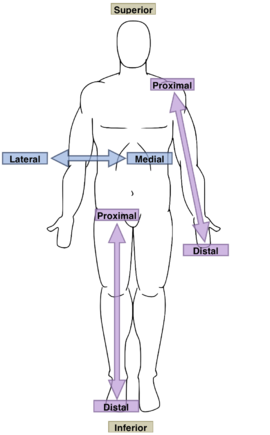Regional Anatomy/Lesson 3
Appearance
Introduction to Regional Anatomy - Lesson 3
Terms of Relationship and Comparison in the Human Body
| Introduction to Regional Anatomy | |
|---|---|
| Lesson: | Lesson 3 |
| Level: | Undergraduate |
| Suggested Prerequisites: | no prerequisites |
| Time Investment: | 25mins |
| Assessment Methods: | Quiz |
| Portal: | Science |
| School: | Biology/Medicine |
| Division: | Anatomy |
| Department: | Regional Anatomy |
| Lesson Coordinator: | =Benjamin= (talk) |


Reading:
[edit | edit source]There are many directional terms used to describe the position of one point in relation to another. These are used frequently in the anatomical lexicon and should be learned thoroughly. The following table introduces the principal directional terms and some examples of their use. If you are comfortable with the basic vocabulary you will be well equipped to understand the ideas in later courses. When reading anatomical descriptions remember that left and right are always in reference to the sides of the subject and not the observer.
| Directional Terms | ||
|---|---|---|
| Term | Region or Reference | Example |
| Anterior | the front, can also be used as "towards the front" | The navel is on the anterior surface of the trunk. The elbow pit (antecubitis) is anterior to the elbow (olecranon). |
| Posterior | behind, can also be used as "towards the rear" | The buttock is on the posterior of the trunk. The shoulder blade is posterior to the rib cage. |
| Ventral | stomach side (in human anatomy is equivalent to anterior) | The navel is on the ventral surface of the trunk. |
| Dorsal | back (spine) side (in human anatomy is equivalent to posterior) | The tail bone is on the dorsal surface of the pelvis. |
| Cephalic | towards the head | At the cephalic border of the thigh is the pelvis |
| Caudal | towards the tail bone (coccyx) (generally only used for structures above the coccyx) | The hips are caudal to the chest. |
| Superior | above; at a higher level | The shoulder is superior to the hip. |
| Inferior | bellow; at a lower level | The hip is inferior to the shoulder. |
| Medial | towards the midline (midsaggital plane) | The medial surface of the arm faces the trunk. The pinky is medial to the thumb. |
| Lateral | away from the midline | The thigh joins to the lateral border of the pelvis. The thumb is lateral to the pinky. |
| Proximal | towards the attached base of a limb (genrally only used for upper and lower limb) | Tracing proximally from the hand brings you to the shoulder. The knee is proximal to the foot. |
| Distal | away from the attached base of a limb (genrally only used for upper and lower limb) | Moving distally from the hip brings you to the thigh. The foot is distal to the knee. |
| Superficial | towards or near to the surface | The skin is superficial to bone. |
| Deep (Profound) | away or distant from the surface | The liver is deep to the rib cage. |
| Dorsal | the back of the hand or top of the foot | The dorsal surface of the foot is hard to walk on. The knuckles are on the dorsum of the hand. |
| Plantar | the base or bottom (or pad) of the foot | The ball of the foot is a plantar structure. People are generally ticklish on the plantar surface of their feet. (note: although plantar refers chiefly to the foot, it is more correct to refer to the foot as well; as opposed to ...their plantar surface.) |
| Palmar | the front (or pad) of the hand | Clapping is achieved by bringing the palmar surfaces of the hands together. There are many interesting palmar structures in the human hand. (note: as with plantar) |
Quiz:
[edit | edit source]for any short answer quiz questions, please answer in lower case.
| Completion status: Ready for testing by learners and teachers. Please begin! |
